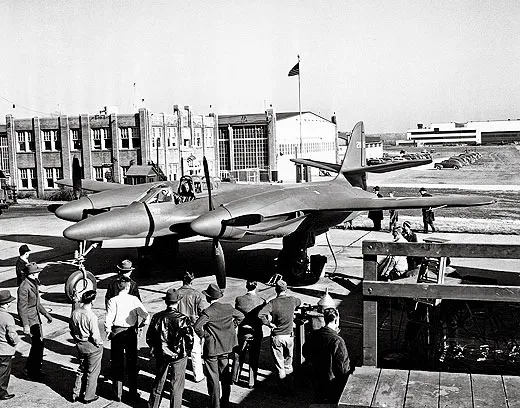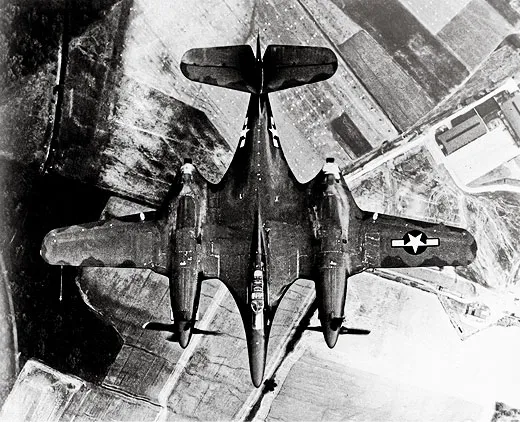Too Hot to Handle: McDonnell XP-67 Moonbat
Man cannot zoom by blended wing alone; he must have an engine that, well, works.
/https://tf-cmsv2-smithsonianmag-media.s3.amazonaws.com/filer/Too-Hot-to-Handle-FLASH.jpg)
Damn Continental engines. No matter how advanced an airframe is, and the McDonnell XP-67 was plenty advanced, you can’t fly a fighter fast and hard if its engines are the product of one of the biggest weapons-procurement boondoggles of World War II.
The XP-67 was a spectacular-looking single-seat twin, the only piston-engine airplane that McDonnell Aircraft ever produced. The company completed just one XP-67 before jets left props in the dust and the Army cancelled the program in 1944. McDonnell’s next airplane was the twin-jet FH-1 Phantom, followed by the F2H Banshee, F3H Demon, F-101 Voodoo, and F-4 Phantom II.
But the XP-67, casually called Bat and Moonbat—―it didn’t live long enough to get an official name—was a futuristic design nonetheless. James McDonnell, a pilot and aeronautical engineer educated at Princeton and the Massachusetts Institute of Technology, apparently became fascinated with the concept of making other airplane structures besides the wings into lifting surfaces. While he was the chief engineer for the Glenn Martin Aircraft Company, he sketched at least one never-flown blended-wing design. Today the blended-wing concept has been greatly refined to mean a tailless flying-wing design, but McDonnell, while at Martin—and then later at his own company with the XP-67—tried to maintain a constant airfoil section on a conventional airframe, from the fuselage centerline all the way out to the wingtips. He included in the blended airfoil the fuselage-to-wing junctures, the engine-nacelle-to-wing interfaces, and even the nacelles themselves. From the conventional tail forward, the Moonbat was all curves. It had the skirted look not of a bat but of a flying squirrel.
McDonnell doubtless was also intrigued by the possibility of decreasing the drag created by the sometimes awkward conjunction of a wing, with its own lifting airflow, and a fuselage—or nacelle—that had entirely different ideas about where the flow should go. The interface usually created turbulence, or interference drag. Most engineers found it easier to lessen such drag with gracefully curved wing fillets or straightforward 90-degree wing-to-fuselage interfaces, typically in the form of wings mounted on the midsection of the fuselage. In fact whatever interference-drag benefit McDonnell might have created was probably nullified by drag from the increased area exposed to airflow on what were essentially oversize fillets.
The engines dated back to 1932, when the Army decided it needed light, compact, high-specific-power, high-revving “hyper” engines ideally configured to be installed, in the fashion du jour, inside future bomber wings or fighter fuselages. The IV-1430 was designed by the engineers at the Army’s Wright Field in Ohio, and Continental simply built what it was ordered to: a two-valve, small-displacement, low-frontal-area, inverted V-12 with separate cylinders (World War I technology) intentionally running its glycol coolant very hot. Intended to produce a competitive 1,600 horsepower, the IV-1430s (also used on the Lockheed XP-49, a modified P-38) never put out more than about 1,060, even after a turbocharger was bootstrapped onto the engine’s single-stage mechanical supercharger.
The Continental was the only true hyper engine to see a modicum of production (23 engines total), but by the time it finally flew, it would have been a nice little motor for the lightweight Air Corps pursuits of the 1930s. Long-range, heavyweight fighters and super-bombers needed a minimum of 2,000 hp per engine.
But it was the engine that Jim McDonnell had been led to believe would be perfect for the buried mounts on the XP-67’s wings. When he discovered it to be troublesome, hot-running, and down on power, he agitated to have the XP-67 given new engines, either Allison or Merlin V-12s. Sorry, the Army said, work with what you have. What McDonnell had were engines so poorly cooled that during initial taxi tests, both caught fire.
The XP-67 first flew in January 1944. After all of six minutes, yet more engine problems forced an immediate landing. It didn’t matter; by then the Moonbat had lost its mission. Conceived in an era when America saw a need to repel long-range German attackers, it was intended to blast apart bomber formations, but by the mid-1940s, neither the Germans nor the Japanese had any effective bombers left. With an intended battery of six 37-mm cannon—never actually installed—the airplane probably could have sawed small ships in half or served as a tank-buster, but it certainly never would have succeeded as a dogfighter.
Longtime contributor Stephan Wilkinson, a former editor of Car and Driver, has come to loathe cars in his dotage and now writes solely about aviation and military history.

